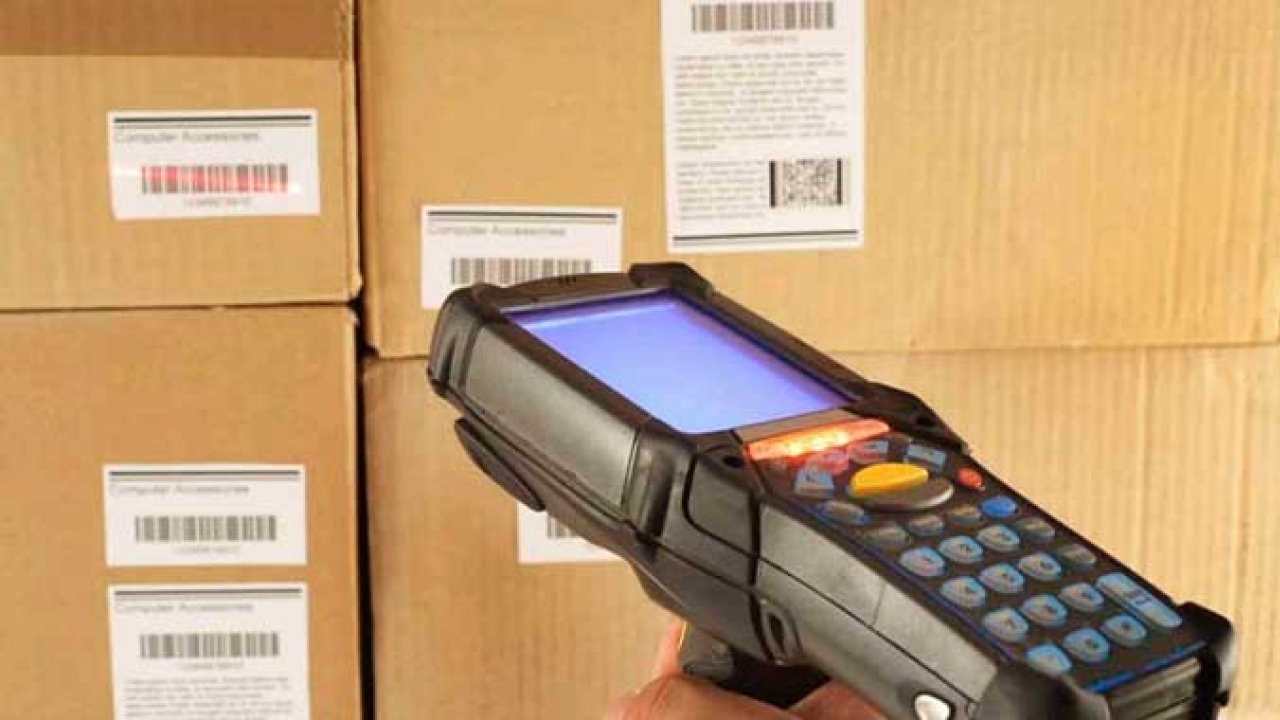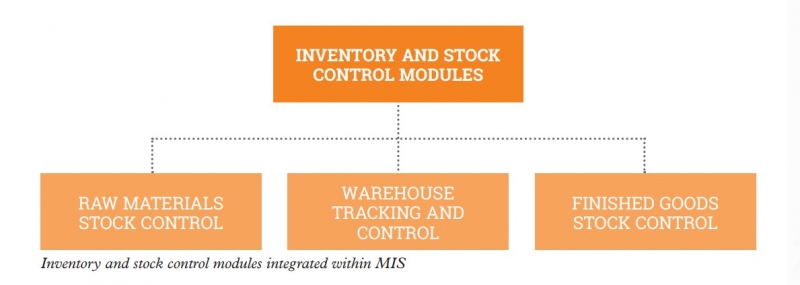Inventory control
In an extract from the Label Academy book ‘Management information systems and workflow automation’, Mike Fairley looks at how to manage your inventory of stock and finished products.

Most label and packaging converters carry a fair degree of stock from paper and film reels, to sheet materials, inks and varnishes, cutting, embossing and foiling dies, spare parts, hot and cold foils, cartons, tapes and staples, and other packaging materials, as well as
holding stocks of finished products or even pre-printed stock products.
All these stocks of production items or finished goods need to be managed as efficiently as possible, and this is undertaken in an MIS inventory management or stock control system – a set of hardware and software-based tools that automate the process of tracking
inventory. Inventory management and stock control may also be closely integrated with purchasing. The kinds of inventory tracked with an inventory control system can include almost any type of quantifiable goods that are likely to be used in a label or package printing plant.
Controlling and managing both stocked raw materials awaiting production and finished goods inventory awaiting shipping, as well as warehouse tracking, is a key part of any management information system – ideally tracking product inventory in real time by scanning a barcode on the item to be recorded and tracked. The aim should be to know what materials or goods are to hand, what items are on order, and what items are needed.
When integrated with purchasing and order entry, stored materials may be automatically allocated to a particular job. As incoming goods are received, an easy-to-use search list identifies them against purchase orders. Each incoming pallet, roll, plate, tool or customer stock can then be tracked into and out of storage by a serial number or barcode, with the quantity received auto-allocated to each job or storage position.
With such sophisticated systems it becomes feasible to agree and store both minimum and maximum stock holdings, avoid unnecessary inventory purchase and production bottlenecks, with the system providing replenishment reporting and even automated inventory management. Inventory control can therefore range from relatively simple to quite complex systems. However, they will most commonly incorporate the same basic key areas of inventory and stock control management. These three key areas of inventory and stock control that need to be integrated within an MIS will need to cover raw materials stock holding, warehouse management and tracking, and finished goods inventory.
Raw materials stock control
A good raw materials stock control system will enable the user to pre-allocate roll material or sheet stock to jobs, show current stock balances and values, together with providing an extensive audit and location trail– job allocation, issue time/date, movement, receipt – of all transactions from the final end job back to its original supplier source, whatever press or process it has been through. Ideally, it will also show traceability of all other jobs produced from the same batch of material.
The stock control system should integrate seamlessly with the order processing, production scheduling and management, quality control and job costing modules. Each action within each of these modules will automatically update related stock levels, keeping stock figures accurate and up to date without the need for manual data entry
Processing an order for production automatically ‘allocates’ the material required in stock control, while raising a purchase order notifies stock that the material is ‘on order’, and recording the materials used through job costing or remote data capture removes it from stock.
The stock control system should integrate seamlessly with the order processing, production scheduling and management, quality control and job costing modules
Most of the MIS systems for labels have a roll tracking facility where rolls are barcoded and through job costing get scanned against a job. This enables full traceability of the rolls used on that job. Some MIS are integrated with a number of material suppliers for electronic ordering with a PO sent electronically. The shipment details then get sent back to the MIS electronically, with the manufacturer’s EPSMA barcode number of the roll and the exact width and length and, depending on the MIS supplier, information about the adhesive, caliper, coatings, and suggested stock substitutions. A scanner can then be used to take roll inventory by scanning all of the roll barcodes, and even allocate specific rolls to certain jobs.
Codes, including barcodes, can undoubtedly make the whole process of inventory control and stocktaking much easier, but it can still be time consuming. Checking stock more frequently – a rolling stock-take – avoids a massive annual exercise, but demands constant attention throughout the year.
For more sophisticated inventory control, RFID tagging using hand-held wireless barcode readers can offer an efficient way to maintain a continuous check on inventory in real-time. Whatever the system, the aim should be to ensure 100 percent traceability of all materials.
For label and packaging converters working with environmental management control or environment audit systems, then their MIS inventory control may also need to add and provide for materials ‘certification’ details (such as FSC certification) to be entered and displayed as required.

The aim should be to know what materials or goods are to hand, what items are on order, and what items are needed
Depending on the warehouse and materials storage process being used, its size, location and management, the MIS may need to incorporate a stock search and viewing facility that will easily identify stock in a particular location. This may in turn mean that a definable storage structure that allocates stock to aisles, rows, levels, etc, has to be established if not already in operation.
On first-in-first-out storage principles the system will show current stock balances and values with an audit trail of all transactions. There should also be full batch traceability from an end product back to its source via whatever machines it was produced on. It should also show the history of all other jobs produced from that same original batch.
A reporting facility will enable ready stock management and should be able to facilitate periodic or annual stock taking, as well as ensuring that stock is not overlooked, that the right balance of stock is in the right place at the right time, that jobs are not held up, and that money is not tied up with surplus or old outdated stock. It should also be closely integrated with estimating, purchasing, costing, production control, quality control and waste management and ideally be based upon the requirements of ISO9000.
Achieving ISO or BSI quality standards is undoubtedly one way of showing customers and regulators that you take quality control seriously. Quality control can therefore be a vital aspect of stock control – especially as it may the quality of the finished product.
Efficient stock control should incorporate stock tracking and batch tracking. This means being able to trace a particular item backwards or forwards from source to finished product, and identifying the other items in the batch. With built in reconciliations for physical inventory adjustments, purchase orders, material receipts, damage roll tracking, spoilage tracking, and shipment cost recording, converters can be confident that the appropriate costs are being recorded and more importantly, billed.

Goods should be checked systematically for quality so faults can be identified and the affected batch or product weeded out. This will allow the converter to raise any problems with the supplier and demonstrate the quality of the products produced. Some systems are also able to enable the addition of ‘product certification’ details to materials, such as FSC certification for environmental audit trail and analysis.
Remember that any inventory control system – whether manual or a sophisticated fully computerized system – is only going to be as good as the original and ongoing data that is entered into it.
Storage of dies and cylinders
The creation and maintaining of a tooling library of cutting, embossing and foiling dies, cylinders and specialized tooling is an important element of stock management and control. The manufacture and use of tooling at the finishing end of a roll-label press often involves engineered products that can be heavier, harder to handle, bulkier and potentially more likely to be damaged or cause damage than in many other label productions applications. Quite simply, moving and handling precision engineered tools during manufacturing or in warehouse, production or storage areas requires specific expertise and training. Solid rotary cutting, embossing or foiling tools, as well as cylinders and anvils, can be quite heavy and a challenge to lift and move in or out of the storage area and handled safely without risk to the tool or the handler. Flatbed, rotary or flexible cutting dies have very sharp edges. Handlers can sustain cuts and the cutting edges can be damaged during handling and preparation for storage. Unpacking of incoming cutting dies and other tooling – and re-packing for storage or shipping – again has the potential to cause damage to the tool or operator during handling. Poor tooling maintenance and storage conditions can lead to deterioration in tools over time.
Such considerations mean that the systems that are used to move and handle tooling as it enters from the supplier, is stored prior to production, moves from incoming goods storage, passes through, and departs the press room, and then back to a storage area for cleaning, packing for storage, and then soring for easy and quick location can be critical to a company’s productivity.
It is not just a case of putting tooling into storage after use. They need to be cleaned, treated (oiled) prior to storage, inspected, protected with chemically treated wrapping, or placed back into the manufacturers shipping boxes for safe storage when possible.
Good storage, transportation and handling systems for all tooling used in label converting operations can significantly reduce costs, increase productivity and create a safer, more ergonomic production environment. Key factors that therefore need to be considered and addressed in the handling and storage of tooling in the label production plant are: checking that there is no transportation or handling damage, either from or to the manufacturer or within the storage facility; the elimination as far as possible of any form of tool damage; making use of optimum handling and storage procedures; the recording of the exact storage position of every item of tooling; the provision of easy access to each individual tool in storage; the elimination or minimizing of any heavy or awkward lifting operations; obtaining a significant decrease in the chance of accidents.
As can be seen, the storage, handling and identification of tooling from incoming tools, during storage, for easy production location in store, after production storage, and then possibly returned to the supplier for repair or sharpening, can be a key to employee safety, productivity and profitability. A raw materials MIS system that can successfully and accurately provide for all these stages – depending on the volume of tooling, the range and variety of tools used, the availability and size of storage area – needs to be carefully discussed with the MIS supplier.
If label and packaging printing plants use external manufacturers for the supply of printing plates, then the same kinds of issues of handling, checking, cleaning, packing and storage of tooling are also going to occur. Again, discussion with the MIS supplier to create a suitable system for the plant needs to be undertaken.
An inventory control system is only going to be as good as the original and ongoing data that is entered into it
Warehouse control and traceability
Relying on a paper trail and the manual entry of data to manage a label or package printing warehouse is not a very satisfactory means of achieving worker productivity and inventory accuracy. Once received as a computer print-out or even a hand-written order, pre- production stock or perhaps finished goods that need to be packed and shipped, will be picked from the warehouse, with a paper trail tracking every step of the process. The information is then manually entered it into the system and filed. Should a discrepancy appear in a customer’s order or invoice, pinpointing the problem requires cross referencing the data in both the system and in filing cabinets.
On the other hand, a good mobile warehouse WiFi scanner with a menucontrolled tracking system within an MIS workflow will automate the flow of information and coordinate key activities in the warehouse in order to maximize efficiency and undoubtedly help to streamline a label or package printing business, enabling the warehouse to be configured into easily identifiable areas and for the rapid tracking and movement of incoming stock, stored stock, finished stock and any work-in-progress.
It should also show goods that have been delivered, but have not yet been allocated a final location, as well as knowing the location of all existing inventory, being able to direct workers to the right storage location, minimize the order picking process, and reduce any impact from products out-of-stock. Get all of these working well and errors will be eliminated and productivity will be improved.
Depending on the MIS warehouse or inventory system or software, it may only be suitable for a single site or be suitable for handling multiple sites. Sites can be configured for tracking and traceability in a variety of ways, from very simple areas, white paper or reel stock warehouse, machine room, dispatch, etc, to very detailed layouts, warehouse, area, bay, rack, shelf, etc.
To make it easy for warehousing systems to record and track reels, pallets, sheets, inks, etc, it may be viable to install shop floor data capture stations or use mobile hand-held scanners. Barcoded reel, pallet or box labels can be generated within such systems, enabling users to locate stock items very quickly by a range of different search criteria, including stock codes, job number, department or section, picking note.
Installing a full-scale warehouse management system can be a costly investment, yet its value is usually quickly recognized. After a warehouse management system has been up and running for only a few months, users tend to say that they cannot envisage how their business worked without it. From achieving real-time visibility into inventory and orders, to decreasing the time it takes to invoice and receive customer payments, a warehouse management information system and package extends mobility to warehouse workers and prepares the business for further expansion.
Finished goods and stock products control
Finished goods and stock products inventory includes barcoded core labels and printed packaging called-off by customers as well as things that are bought to be resold like ribbons and printers.
There should also be a means of setting expiry times on stock. Increasingly, MIS suppliers are also being asked to incorporate interfaces to transport suppliers, enabling the sending of electronic instructions to DHL, UPS, etc, in order to manage transport and shipping.
The primary function of finished goods and stock products control is to manage all printed stock and consignment stock held either on behalf of customers or for direct re-sale – including managing inventory cost. This all needs to be closely integrated with work instructions, delivery notes and invoicing, provides a fast and seamless stock movement and management system that greatly reduces the opportunity for human error.
All the features of raw materials stock control will also apply to finished good control; first-in-first-out full audit trail; batch control and barcode traceability; a sort-filter-find engine and full integration with report and document generation.
Finished Stock call-offs can be received and entered either manually or through EDI and e-commerce web-to-print orders to generate picking notes.
Stay up to date
Subscribe to the free Label News newsletter and receive the latest content every week. We'll never share your email address.


